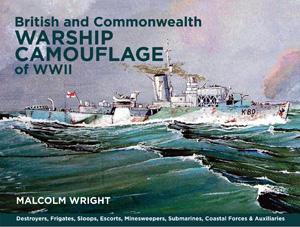
British and Commonwealth Warship Camouflage of WWII: Destroyers, Frigates, Escorts, Minesweepers, Coastal Warfare Craft, Submarines and Auxiliaries. By Malcolm Wright. Seaforth Publishing, Barnsley South Yorkshire, 2014, 160 pages.
Reviewed by Tim Coyle
WORLD War 2 wasn’t fought in black and white. So ran the promo for a TV series depicting military operations in rare colour film some years ago. So too for the war at sea as the fascinating little book proves. The Australian author Mal Wright tells us that his work is the result of over 50 years of research into the often bizarre camouflage patterns of destroyers and lesser naval combatants of World War II.
Wright’s sources include former shipyard workers and naval personnel responsible for daubing their ships in the colourful patterns to confuse enemy submariners and airmen. The many hundreds of profiles and overhead drawings reproduce the myriad patterns as faithfully as possible to the official paint schemes with a key to the various paint colours.
Wright accompanies his profile drawings with chapter headings of his paintings depicting the camouflaged warships in action at sea. The reader can spend hours dipping into this book marveling at the imagination of the scheme designers and the reasons for the particular schemes. One of my favourites is HMS Nith, a River-class frigate designated as a Brigade HQ ship for the Normandy landing. Her colour scheme was overall ‘red lead’ undercoat.
While Wright endeavors to depict the accuracy of the camouflage schemes, he gives due weight to the ‘that looks about right’ treatment which ships’ companies interpreted when the correct mix of paint tints either did not arrive or was somehow messed up. His interlocutors made this point plainly when working under stressful wartime conditions.
The book is not just paint patterns. Each drawing carries armament, sensor and physical characteristics information relevant to the overall ship’s appearance. As the title indicates the book includes Commonwealth navies so there is a good representation of RAN ships.
The coverage of minor war vessels such as trawlers, auxiliary AA ships, coastal forces and miscellaneous vessels is particularly absorbing. Brave little paddle steamers such as HM Ships Jeanie Deans and the imperiously named Emperor of India left their pleasure steamer trade and hoisted anti-aircraft guns on board for the desperate defence of the English Channel in 1940. They live again in their somber camouflage in this book.
British and Commonwealth Warship Camouflage of WWII is very well laid out with a ship index and is indispensable to modelers and warship historians. It is a worthy tribute to the salt and rust-grimed little ships manned by the thousands of Hostilities Only officers and ratings who have now passed from our sight.



